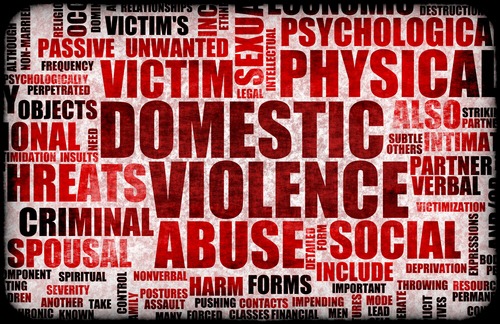Domestic Violence

 As a Marriage and Family Therapist I see many couples in therapy who are very unhappy and who are trying “one last time” to understand and fix the chaos in their marriage. There are several issues that bombard a marriage with pain, confusion and hurt, but none as destructive as domestic violence. I also see family members that are at the end of their rope and cannot understand why they are not able to be in the same house without painful and abusive arguments.
As a Marriage and Family Therapist I see many couples in therapy who are very unhappy and who are trying “one last time” to understand and fix the chaos in their marriage. There are several issues that bombard a marriage with pain, confusion and hurt, but none as destructive as domestic violence. I also see family members that are at the end of their rope and cannot understand why they are not able to be in the same house without painful and abusive arguments.
Contrary to the perception of the majority of laypersons, domestic violence is not only seen in a heterosexual relationship where the man is the perpetrator. Domestic violence crosses all relationship types and cultures. It can occur in partner/marriage relationships, against children and the elderly as well as against disabled family members.
Defining Domestic Violence
Domestic violence, which is also known as intimate partner violence (IPV), refers to the victimization of an individual who has or has had an intimate or romantic relationship. The CDC, Centers for Disease Control and Prevention, defines IPV as: “physical violence, sexual violence, stalking, and psychological aggression (including coercive acts) by a current or former intimate partner.”
Domestic violence sometimes starts so gradually that the people involved do not even know if they should term it as domestic violence. It is a pattern of behaviors that adults or adolescents use against their intimate partners to establish power and control. These can include physical abuse, sexual abuse, emotional abuse and economic abuse. Threats, isolation, pet abuse, using children, and a variety of other behaviors are often used to maintain fear, intimidation, and power over one’s partner, or other family member.
Healthcare professionals are often the first to see the physical abuse when a spouse, partner or elderly/disabled family member goes to the emergency room. By law, if a healthcare professional suspects domestic violence they must report it to the authorities.
Although estimates vary greatly, as many as seven million children are exposed to domestic violence each year in the U.S. Often, children exposed to domestic violence are the unseen victims of domestic violence because they are not always the direct victims. In reviewed cases, most children had been exposed to domestic violence in some way prior to the homicide(s). A significant number of children from reviewed cases witnessed the death of their parent of caregiver(s) or were in the vicinity of where the homicide happened.
I ask all my patients if at any time in their lives they have been a victim or a perpetrator of domestic violence. This question usually opens a segue into a psychoeducational opportunity where we can define the parameters of domestic violence. People often act out in behaviors they do not quite understand due to past exposure to domestic violence.
The danger of working with couples living in an active domestic violence environment is that what may seem as a benign discussion in the therapy room could explode into dangerous and even life threatening violence once they are home.
When a therapist has discerned that there is domestic violence present it is best to evaluate the extent and behaviors and address it by offering solution-focused, non-judgmental interventions. Couples therapy at this point is iatrogenic to the wellbeing of the partnership. The therapist may need to report the violence to the local authorities.
In these very unstable situations it is best to meet with each person alone: however if the extent of the domestic violence is profound, the perpetrator may not allow a separate therapy session for the victim. All victims of domestic violence should somehow be advised to create an escape plan. All therapists should have knowledge of local save shelters for victims. Batterers groups for the perpetrator are usually part of the legal treatment plan. Once the legal issues are dealt with and the victim is safe our therapists can help with further therapy with the family, children, women, men and partners. There must be a systemic approach to the therapy provided the victims and perpetrators of domestic violence. This means that the person; who they believe they are, what they expect, where they originated from and where and who with they are going in the future needs to be taken into account and addressed in the therapeutic process. There is a great possibility for healing of the partnership, the marriage, the individual and the children with psychotherapy.
Resources for Survivors of Domestic Violence
Here are some places to call if you think you are a victim of domestic violence. Most offer emergency shelter, legal/financial help, counseling services for you and your children and some offer long term housing.
Cherokee Family Violence Center: 770-479-1703
Gateway Domestic Violence Center: 770-536-5860
Peace Place: 770-586-0927
Ahimsa House: 404-452-6248
International Women’s House, Inc.: 770-413-5557
Partnership Against Violence (PADV): 404-873-1766
Women’s Resource Center to End Domestic Violence: 404-688-9436
Women Are Dreamers Too: 404-477-4211
Project Renewal: 770-860-1666
Circle of Hope: 706-776-4673
Project Safe, Inc.: 706-543-3331
Support on Abusive Family Emergency: (SAFE): 706-379-3000
No Georgia Mountain Crises Network, Inc.: 706-632-8400
SHARE House, Inc.: 770-489-7513
Addendum
The Georgia Coalition Against Domestic Violence (GCADV) and the Georgia Commission on Family Violence (GCFV) released their 12th annual Georgia Domestic Violence Fatality Review Report (Report) in March of 2016. Here is a brief review of key findings quoted from the Report.
At least 12,000 children in Georgia are exposed to domestic violence annually and that exposure can have serious effects on children
Many children witness the homicide of their parent.
Children are killed in domestic violence homicides.
Children who lose a parent to domestic violence homicide face challenges and need services.
Surviving family members also face challenges and may also need services.
Children exposed to domestic violence are resilient but need our help to succeed.
For additional information and statistics regarding this social issue, please visit http://gcadv.org/georgia-fatality-review-report-released-domestic-violence-deaths-10-year-high/
